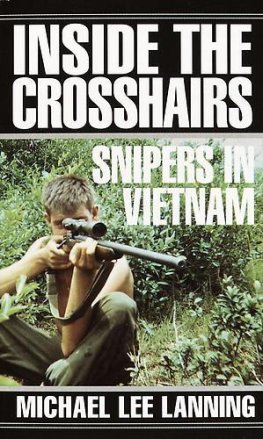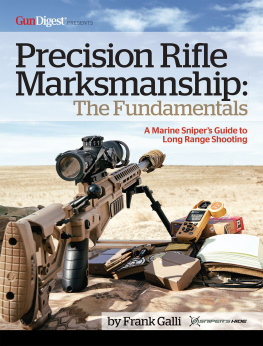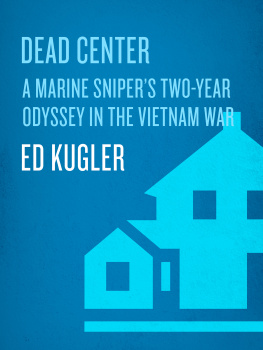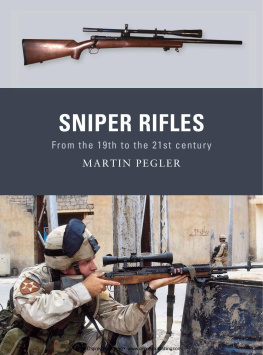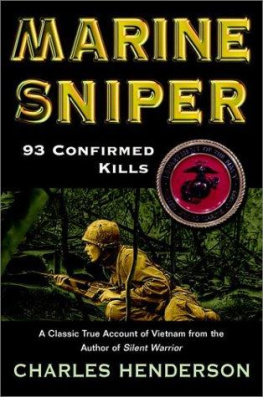

Table of Contents
The snipers rifle spit leaden death intothe Marine ranks again, and anotheryoungster cried out in pain and mortalfear. Loren Kleppe raised his rifle abovethe bunkers lip and sighted in on a darkshadow that lay facing his bleeding brothers.The smoke and debris that had filteredover the battlefield made a clear sightingimpossible. The Viet Cong sharpshooter nodoubt felt a degree of safety, with theMarines bloodied and confused by mortarrounds still tearing into the sand dunes asthey lay stunned and weary.
Loren took up the trigger slack, and theM1-D bucked hard against his shoulder.The heavy match bullet tore through theshort hundred-meter distance betweenfriend and foe. Kleppe couldnt see clearlythrough the smoke as the Viet Congsnipers head blew apart like a pumpkinsmashed by a mallet during a Halloweenprank back home. No more shots werefired from the enemy bank, and Kleppeslumped down like a drugged animal intothe bottom of his bunker....
In every great military unit there exists an outstanding leader who unites and motivates the men. In the 13 Cent Killers of the 5th Marine Snipers Platoon that standout warrior was Thomas Casey. Casey was not only the finest sniper team leader, but he was also the epitome of the 13 Cent Killers on his own skill and merit. Sergeant Casey led over forty night ambushes personally and was responsible for the deployment and record number of enemy WIA/KIAs during Vietnams bloodiest and hardest fought battles in the pivotal year of 1967. Sergeant Tom Casey has emerged as the most deadly of all American Snipers in Vietnam and the heroic example of what it means to be a combat Marine.
Foreword
Musketry, the ability of riflemen to hit their target with aimed fire, is a very important skill in the United States Marine Corps even in this modern age of stealth fighters and laser-guided bombs. This tradition carries back to the age of sail when leathernecks were posted in the foretops with orders to pick out and shoot enemy leaders during ship-to-ship fighting on the high seas. The steel-and-steam navy of the late nineteenth century eliminated this mission, but the Marines still retained their emphasis upon sharpshooting.
In 1917, the 5th Marine Regiment was part of the initial component of the American Expeditionary Force sent to France during the First World War. When the Marines began to prepare for combat under the tutelage of French veterans, the American commander was astonished to find no time on the training syllabus for rifle marksmanship. He was smugly told that there was no place for the individual rifleman in modern warfare because machine guns and massed artillery firing from deep trench lines were the arms of decision on the Western Front. The stubborn Marines, however, rejected this tenet and quickly added rifle marksmanship to the training schedule even though French officers shook their heads in disbelief at such a waste of time. Not long thereafter, the Allied defense lines were shattered by a surprise German offensive. Soon, the French Army was in full retreat and a German juggernaut was headed straight for Paris with its way unblocked by trenchlines, machine-guns pits, or artillery batteries. Into this breach marched the 5th Marines. When a distraught French major ordered the 51st Company to fall back, Marine captain Lloyd Williams replied, Retreat, hell! We just got here.
The next day the lead units of the Kaisers army approached Belleau Wood located less than forty miles from the suburbs of Paris, so close that German artillery spotters could pick out the Eiffel Tower and the spires of Notre Dame cathedral with their binoculars. German scouts were suddenly taken under fire and more than a few fell to the ground, victims of astoundingly accurate rifle fire, as they neared Les Mares Farm. The German commander then did what had worked so well for the last few weeks; he ordered a frontal assault, expecting the inexperienced and out-gunned Americans to turn tail and run. Wave after wave of Feld Grauclad Prussian Guards were cut down as they advanced through the wheat by well-placed shots from American M1903 Springfield rifles. Les Mares Farm turned out to be the closest the Germans got to Paris during the First World War. The tide of the war had been turned with the help of God and a few Marinesmen who knew how to make every shot count.
This book also tells the story of a few good men who knew how to make every shot count. In its pages we learn about the men of the 5th Marines Sniper Platoon who worked the blood-soaked ground south of Da Nang in 1966 and 1967. Their stories are skillfully told by John J. Culbertson, himself one of their number during that time. Culbertson offers a moving testament to the forgotten heroes of a misunderstood warmen who unflinchingly placed themselves in harms way only to have their efforts belittled by many who refused to serve. Culbertson lovingly and respectfully documents the exploits of these few brave and humble men, but at the same time, he paints a larger picture, giving the reader the full context of time and place, enumerating tactical lessons learned, and debunking many myths as he recounts the 1st Marine Divisions initial year in the Republic of Vietnam. We follow men like Tom Casey, Ron Willoughby, and Vaughn Nickell as they fight the Viet Cong and North Vietnamese in the An Hoa Basin and the Que Son Valley. Culberston details how the men were trained, describes the equipment they carried, and explains the tactics they used while serving in the Marine Corpss most decorated regiment, the Fighting Fifth Marines.
Although Private First Class Culberston and I served in Vietnam at different times, by virtue of serving in the same unitthe Fighting Fifth Marineswe certainly walked a lot of the same ground and there can be little doubt that we fought many of the same people. John Culbertson is well qualified to tell this story. He lived parts of it and gained firsthand testimony about the rest from his comrades-in-arms. Thus, this book is not a distant historical tome whose facts were pulled from some musty long-forgotten documents, nor is it the retelling of some self-serving sea stories by a wannabe hero. ThirteenCent Killers, just like Johns two previous memoirs, Operation Tuscaloosa and A Sniper in the Arizona, contains the authentic memories of someone who was there and experienced firsthand the heat and mud of battle. Culbertson once again splendidly mixes personal experiences with historical fact to present the unvarnished truth about what the war in Vietnam was like for those who fought it.
Our paths first crossed when I was researching my own history of the 5th Marines. John was forthright in his criticism and accurate in his assessments so I frequently used information he provided in that book, AFew Good Men: The Story of the Fighting Fifth Marines,the USMCs Most Decorated Regiment. John joined the Marines in 1965, volunteered for combat duty in Vietnam, and was eventually assigned as a rifleman with Company H, 2nd Battalion, 5th Marines, in 1966. The highlight of his tour of duty was two weeks spent at the 1st Marine Division Sniper School, an experience he describes as both enjoyable and educational. The friendships he made during that time and the lessons he learned there are the bedrock upon which this book is built. Culbertsons last Purple Heart Medal doubled as his ticket home (Marines were sent stateside after receiving a third wound) for duty at Quantico, where he quarterbacked the all-Marine football team in 1968. Following his separation from the service in 1969, former Sergeant Culbertson used his G.I. Bill benefits to get a college degree, but it took many years and a lot of soul-searching before John finally took pen to paper to chronicle his experiences as a combat Marine. We are all better off because he decided to do that, and this book is one more fine addition to his outstanding body of literary work.
Next page

